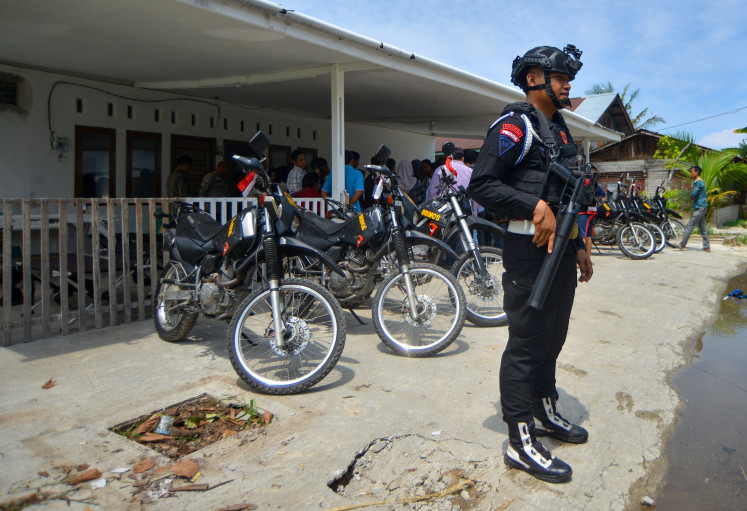Popular Reads
Top Results
Can't find what you're looking for?
View all search resultsPopular Reads
Top Results
Can't find what you're looking for?
View all search resultsWeekly 5: Elements of acculturation in Betawi culture
JP/PJ
Change text size
Gift Premium Articles
to Anyone
JP/PJ. Leo
As interaction between people of different backgrounds is inevitable, acculturation becomes unavoidable. Jakarta, which has been Indonesia’s melting pot for decades, has experienced cultural changes because of the interaction of the indigenous Betawi people with people from different ethnic groups, such as Chinese and Arabic people. Some products that resulted from the acculturation are obvious while some others are not. Here are five elements adopted by Betawi culture:
Kebaya Encim and Sadariah shirt
A kebaya (traditional blouse) has different motifs depending on in what regions or countries it is made. Betawi people have Kebaya Encim, whose name is derived from the Chinese word enci or encim, which refers to married Chinese women.
A Kebaya Encim is a blouse that incorporates symbols and motifs from China, such as dragons, phoenixes, peonies and lotuses.
Its history dates back to the 15th century when many Chinese migrated to the archipelago. Many Chinese people living in Betawi married local girls. The girls continued to wear kebaya, but they inserted those Chinese cultural elements.
Meanwhile, a sadariah, also known as a baju koko, is a long-sleeved white shirt worn by males. Having a shorter size, the shirt is actually a simplified version of an Arabic robe. Like a robe, the shirt is collarless. The sadariah shirt is normally worn with black trousers or a sarong and peci (velvet cap).
Betawi wayang show
A wayang (puppet) show is often associated with Javanese culture, but the Betawi have their own version of performance, although it was no doubt adopted from the mainland Javanese wayang tradition. Overall the shape of a Betawi puppet is similar to a Javanese puppet that is made of buffalo skin and therefore has a thin shape. What is different is the way a show is performed.
The Betawi puppet show is performed using the Indonesian language, although the intonation and the pitch are made in such a way to resemble Javanese intonation. Meanwhile, the background sounds accompanying the performance are normally Sundanese songs rather than Javanese songs.
Another feature that makes the Betawi Wayang different is that the Betawi puppet show normally presents stories adopted from daily life rather than from the Mahabrata and Ramayana sagas, like the Javanese puppet shows normally do.
Gambang Kromong
A gambang kromong is a traditional Betawi orchestra that merges a Javanese gamelan ensemble with Western music and a Chinese pentatonic scale (five notes per octave).
The orchestra consists of the gambang (a xylophone-like instrument), kromong (a set of small gongs), tehyan (a Chinese string instrument), flute, a percussion set, gongs and kecrek (a musical instrument with two or four thin metal discs attached to a frame). Western instruments, including the electric guitar, trumpet, clarinet, saxophone, electric keyboard and Hawaiian guitar, are also played.
The singers, mostly female, sing pantun (lyrics written in the Betawi dialect) with shrill voices.
Ethnomusicologists say that the texture of gambang kromong is similar to that of Javanese and Sundanese gamelan orchestras and also has echoes of the “small-band jazz” music popular in North America and Europe in the 1920s and 1930s, not to mention a strong influence from Chinese music.
These orchestras usually accompany traditional Betawi dances, new dance performances and lenong (Betawi comedy shows).
Language
There is probably no other element in Betawi culture that has taken as many outside influence as the Betawi language.
The Betawi language is actually an old Malay language — the language spoken nationwide in Indonesia today — but it is spoken differently, with a different accent and pitch. Besides the intonation and the pitch, the Betawi language is different from the Indonesian language in general because it adopts words from other languages.
Some words in Betawi have been borrowed from the Sundanese and Balinese languages, as well as from Chinese (especially Hokkian). The language also adopted some words from some European languages, such as the Dutch and Portuguese.
JP/PJ. Leo
Cokek Dance
The cokek dance is one of the traditional dances found in Betawi culture that is heavily influenced by Chinese culture. Some people say even the word cokek itself comes from Chinese cio kek, meaning dancers and songs, although the assertion cannot be confirmed because cokek could also refer to the kebaya blouses worn by the dancers.
The dance is accompanied with the traditional kromong musical instrument. The dance is opened with dancers lining up before they step back and forth according to the rhythm of the kromong. The dancers sometime invite guests to join them.











